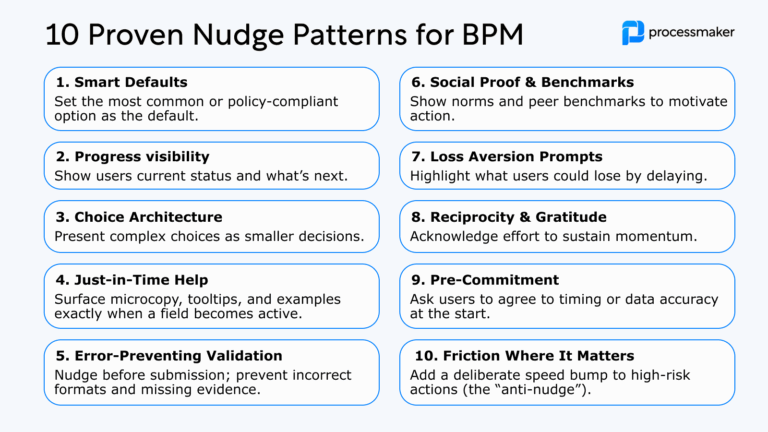Business process management (BPM) has been through many technological advancements. Perhaps the most important, would be artificial intelligence (AI) being introduced and more widely used as a driving force behind process automation. In July, CCS Insight fielded the most recent survey regarding senior leadership IT investment. This survey reported that 80% of the firms surveyed have already put AI to use or are currently experimenting with the use of AI, while just a year prior, the figure was only at 55%.
Invariably, business process automation can be brought about by integrating machine learning models (AI) with BPM platforms. For instance, data can be collected by performing the same task continuously and in turn, that data can be used to update automation models dynamically. As time goes, the AI being used can adjust itself accordingly to improve the quality of its work.
An additional way in which AI can be utilized is by taking machine learning models and reusing them for processes with similar sets of data. These learning models have the ability to be molded and used in a new customer’s model, which can minimize the extra time and data that would normally be required to build and execute a brand new model.
BPM + AI: Job Destroyer or Job Creator?
When tasks can be automated by use of AI, other critical tasks requiring people resources can gain the attention needed to carry out more strategic functions of the business. While cost saving can result from the use of automation, it may not take away from human jobs the way many believe it will.
With automation freeing people’s resources, there are newfound opportunities to re-allocate those resources to sections of business functions that may not have been possible in the past. This can bring further innovation and new projects that never came to fruition in the past due to costs and time resources. If the new projects are able to utilize some of the automation through AI, it would reduce the cost, making it possible to execute.
In fact, creative innovators would have the ability to take part in more opportunities by harnessing the use of AI. When deciding how AI should be used within a business, the executive and IT professional should select the valuable projects that have been avoided due to costs and tasks which are much too repetitive.
Quality assurance, manufacturing, and customer support are functions able to be automated using AI. Video processing can also be used in the job interviewing process in ways to identify a candidate’s intangibles in a scientific way. Certain facial expressions and behaviors are found to be consistently successful in sales, customer service, and additional interactive functions similar to those. Using AI can assist with identifying those specific patterns. It takes people to create and implement these technologies. CapGemeni found in a recent survey that more jobs will be created by AI than destroyed, similar to the way that the value created by technological advancements has outweighed what it has eliminated.
Lower costs, better customer service, and even more successful project implementation can be a result of using AI to automatic basic tasks within the business. For example, while a 18-wheel cargo truck that operates autonomously is helpful financially by saving the amount of money to salaried drivers, it is even more valuable to know that the autonomous truck can operate 24/7 without the need for food, sleep, or rest stops. The reason is because minimizing shipping time in an incredibly valuable part of a business. Making this kind of automation happen can even add to the shelf life of perishable foods, ultimately leading to reduced grocery waste.
A necessity for any business to stay viable
Gartner stated that by 2020 any data center that has failed to incorporate AI and ML into their practices will no longer be operational or viable, economically. The AI in question is not far from being developed or impossible, like science-fiction, it is available to us currently and crucial for the viability of any organization in the future, no matter the industry.
Instead of IT driving businesses toward the use of AI, we will likely see it happening in the other direction. Business and competition will increasingly drive the needs for artificial intelligence. While AI might start within many organizations as a one-off project they are testing, the more those projects succeed with lower costs and increased simplicity of AI, the quicker we will see additional projects integrating AI and transition toward robotic process automation (RPA).
While AI does process unstructured data, such as images and audio, the data it produces is structured and requires additional structured data in order to conduct a solution. For example, if you have an automated greeter at a store, the customer can come in, hold up a picture of an item they might be searching for, and be presented with information by the greeter. The automated greeter may include its aisle location, whether or not it’s in stock, or any other important information. AI-enabled training will assist with the image recognition part of the interaction, but it requires integration with the product catalog information, inventory, and others in order to present the customer with the information they need.
A small research and development project is a straightforward way to get started with the process of automation. Start with a few specific ideas, but those developing the technology could benefit from a more open-ended ability to create and develop solutions during the early stages of the process. When a few prototypes are created, they can be reviewed and maybe one can be pushed into the production process at that time. The R&D team can continue repeating this process, pending success, before moving forward with other similar projects.
Using data as the guiding light
The first things an organization needs to do is decide where their AI tasks will run, either their public cloud or private cloud. The data gathered can guide this decision. Large data sets win when it comes to training AI networks, which means organizations have to use AI where their data is. Because data is so complex and expensive, the process needs to follow the data rather than the data following the process.
If on-prem data is slated to be integrated with other on-prem structured data, then it would make sense for the AI to also run there, much like if the data sets come from the public cloud through any web-based services or a natural place for your IoT data sets, then it would make sense for your AI data to be run there as well.
Every single industry will be changed by AI, but in different ways and on different timelines. ProcessMaker makes it easy for business users to collaborate with IT to automate complex business processes connecting people and existing company systems. If you’re ready to learn more about integrating your own cloud AI models with a low-code business automation platform, contact us today.





